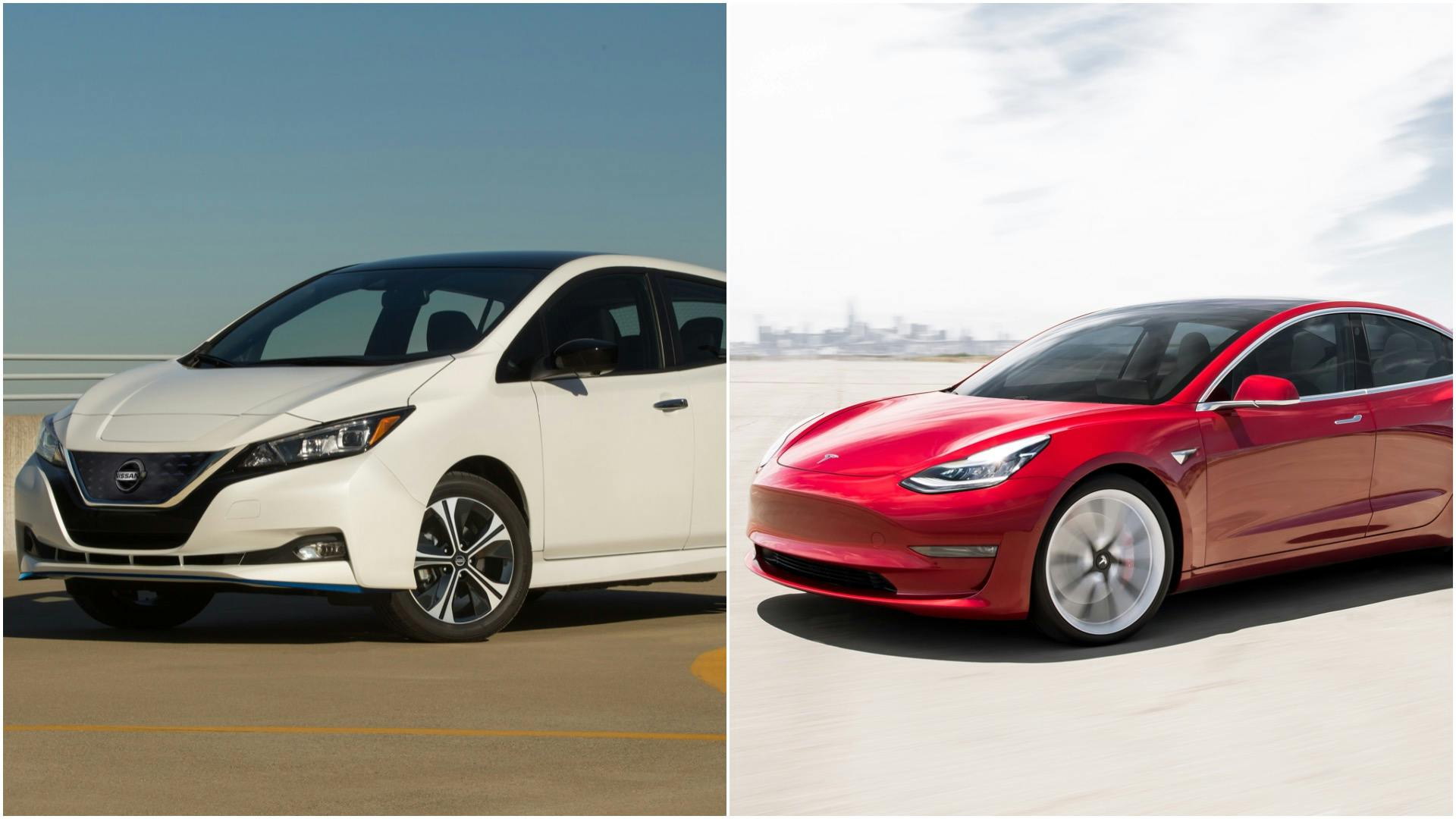Electrification is upon us and two automakers are at the forefront of that: Nissan and Tesla. Both are pioneers in electric vehicle development but each one took a different route in bringing out their entries. Now, Tesla and Nissan each have 200-mile EVs that are within the reach of the average consumer. Which one is best for you? Let’s find out.
2021 Tesla Model 3 Standard Range Plus vs. 2021 Nissan Leaf Plus exterior
Both the Tesla Model 3 and Nissan Leaf are compact cars but are of different body styles. The Leaf is a hatchback and is more upright, giving it a more familiar look. You find a nice blend of futuristic and conventional in the Leaf, giving it a tasteful appearance that will surely age well.
In comparison, the Tesla Model 3 is a sedan that flaunts a curvaceous, wind-cheating design. That gives the Model 3 a more distinctive appearance especially with the all-glass roof, short deck lid, and grille-free front fascia.
2021 Tesla Model 3 Standard Range Plus vs. 2021 Nissan Leaf Plus interior
The interior is where the Leaf and Model 3 start to distinguish themselves from each other. Being a hatchback, the Nissan is versatile and able to carry more than you think it can for a compact car. There’s a lot more vertical space too, allowing you to haul bulkier and/or tall items.
The Tesla Model 3, on the other hand, is equally roomy but you lose versatility because it’s a sedan. You don’t get a squared-off space since you have a trunk instead of a hatch. You can fold the rear seat backs, too but that opening still isn’t as big as what you’d find in anything with a liftgate.
PRICING: 2021 Nissan Leaf pricing
There’s a small frunk in the Model 3 because of how compact its powertrain components are, giving it additional cargo capacity. Both cars will seat four comfortably, making them a good choice if you’re carpooling with people on the daily commute.
Fit and finish fall on the mainstream end of the spectrum for the Leaf and Model 3. There’s a good mix of materials but you can tell they’re not high-end.
2021 Tesla Model 3 Standard Range Plus vs. 2021 Nissan Leaf Plus tech
Tesla has an advantage on the tech front. Their semi-autonomous driving features are some of the most effective on the market, helping minimize the stress of commuting. Upgraded versions even allow the Model 3 to navigate to your destination via the Autopilot driving assist system and execute lane changes on its own. The car even gets summon and self-parking features.
The Leaf isn’t far behind because it’s got some cool tech features too. Nissan’s ProPilot Assist gives you the ability to keep adaptive cruise control active in traffic and will even accelerate and stop for you. There’s even some degree of self-steering as long as the road is well marked.
PRICING: 2021 Tesla Model 3 price and features
On the infotainment front, the Tesla Model 3’s 15-inch touch screen is where you’ll find everything. From car settings to radio and navigation, you’ll find it all on there, meaning there’s a learning curve. In comparison, the Nissan Leaf is a more user-friendly interface with a simpler layout complete with knobs and buttons. In terms of graphics, the Tesla Model 3 leads with clarity and vividness.
2021 Tesla Model 3 Standard Range Plus vs. 2021 Nissan Leaf Plus driving impressions
Tesla continues to prove that going electric doesn’t have to come at the cost of driving enjoyment. The Model 3, even in the Standard Range Plus version, is fantastic to drive, offering agile handling, communicative steering, and quick acceleration. With 263 miles of range per charge, this version gives consumers a usable amount for daily driving, meaning you can commute for a few days before needing to charge again. You don’t lose out on comfort, either. The Model 3’s ride is exceptionally compliant and does a good job soaking up bumps to isolate the passenger compartment.
The Nissan Leaf doesn’t try to hide that it’s a commuter car. Although body roll is minimal and it steers accurately, you don’t want to push the car too hard because it’s lacking grip. Unlike the Model 3, which offers instantaneous acceleration, the FWD Leaf limits torque from a standstill to avoid overwhelming the front tires. There’s less sound insulation too, allowing more wind noise to enter the cabin at highway speeds compared to the Model 3. The less sophisticated torsion beam rear suspension in the Leaf doesn’t absorb road imperfections as well as the Tesla, especially successive ones. Even with the Plus variant’s 62-kWh battery, the Leaf trails the Model 3 Standard Range Plus at 215 to 226 miles per charge.
Nissan’s e-Pedal system is a great differentiator on the Leaf because it helps you learn one-pedal driving quicker. This means you get used to not having to step on the brake pedal as often, and simply easing off the accelerator to slow the car down into a full stop. The only time you’ll use the brake pedal is for additional stopping power during emergencies or evasive maneuvers.
Summary
Get the Tesla Model 3 Standard Range Plus if you want:
- Sporty driving dynamics
- An eye-catching exterior
- Generous range
- Cutting-edge tech features
Get the Nissan Leaf Plus if you want:
- Tools to help you learn the ins and outs of EV motoring
- Need extra space in a compact package
- A user-friendly infotainment system
- Federal tax credits

